
A push notification is a brief, targeted message delivered directly to a user’s device—be it a mobile phone, desktop browser, or connected gadget—even when the app or website isn’t active. They’re powerful touchpoints, instantly notifying users of updates, reminders, promotions, or other essential alerts.
Push notifications can originate from mobile apps or web platforms. On mobile devices, they typically pop up as banners, lock-screen messages, or notification center alerts—regardless of whether the app is open. Web push notifications are sent via browsers and can reach users even without an installed app, offering a broader channel for engagement.
Composed of elements like app icons, titles, brief messages, call-to-action buttons, and sometimes media like images or emojis, these notifications are crafted to grab attention quickly.
Push notifications deliver unmatched immediacy. Appearing right on device home screens or notification centers, they outperform emails or in-app messaging in capturing attention and prompting action. They drive remarkable engagement and retention—helping users return, complete tasks, or stay informed.
Statistics show that push notifications can increase user engagement substantially—sometimes up to 191% compared to users who receive none.
They serve multiple functions: confirming purchases, notifying about deliveries or restocks, delivering reminders, promoting campaigns, sharing news, or even enabling transactional interactions like booking alerts or security updates.
Mobile App Push: Sent via iOS or Android apps to directly reach users.
Web Push: Delivered through web browsers—even without an app—ideal for desktops and cross-platform reach.
Connected Device Notifications: Target devices like smart TVs or wearables, enabling alerts across emerging tech environments.
Visibility: Messages are instantly seen—no inbox clutter.
Engagement & Retention: Re-engage users and reduce churn.
Conversions: Ideal for call-to-action triggers like limited-time offers or in-app deals.
User Experience: Enhance guidance, updates, and timely communication.
Scalability: Easily engage growing audiences across platforms.
Request Permission Thoughtfully
Avoid asking for permission immediately. Build trust first, then explain the value—such as order updates or timely alerts—before prompting the opt-in. Proper timing significantly improves acceptance rates.
Keep Notifications Purposeful and Actionable
Every message should offer clear value. Transactional prompts (like boarding pass ready or shipment status) work best because they provide utility and direction.
Avoid Overuse and Timing Fatigue
Too frequent or ill-timed notifications can lead to dismissal or opt-out. Respect user context and combine effective timing with relevant content.
Segment and Personalize
Customization based on user behavior or preferences boosts relevance and response rates. Personalized alerts outperform generic broadcasts.
Optimize Send Timing
Analyze when users respond best—statistics show mid-morning and early evening are peak engagement times. Tailoring schedules based on such insight improves click-through rates.
Ensure Opt-Out Options
Always provide easy ways for users to pause or stop notifications. Transparency builds trust and respects user preferences.
As workplaces and apps evolve, push notifications are becoming more strategic—from simple alerts to intelligent, adaptive communication tools. With AI, they’ll anticipate needs, reduce noise, and offer personalized guidance across devices. By managing timing, content, and user context intelligently, future notifications will enhance interaction rather than disrupt it.
In sum, push notifications are immediate, powerful channels—uniting engagement, convenience, and efficiency. Used thoughtfully, they connect users to relevant content at the right moments, driving stronger communication and better app and workplace experiences.
